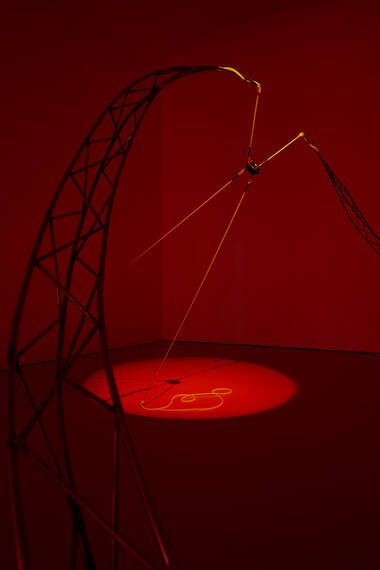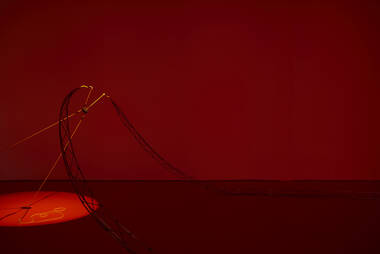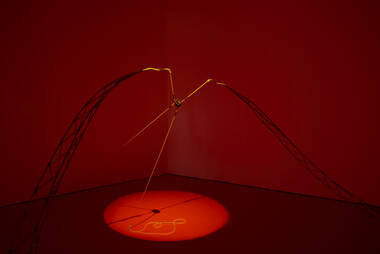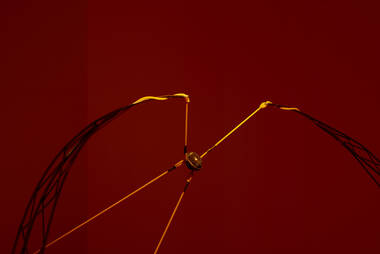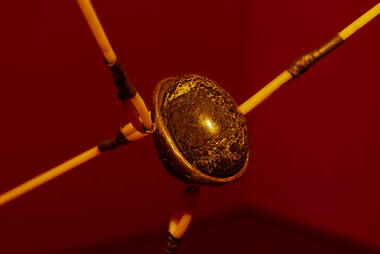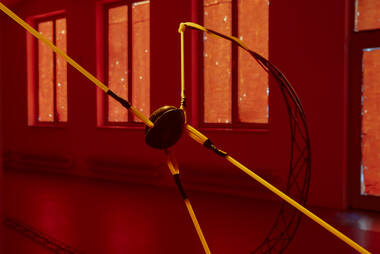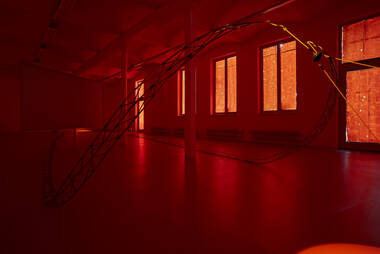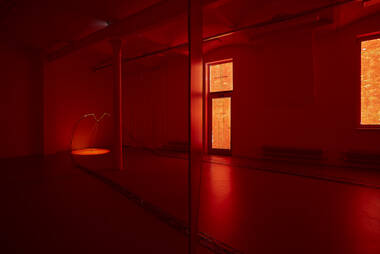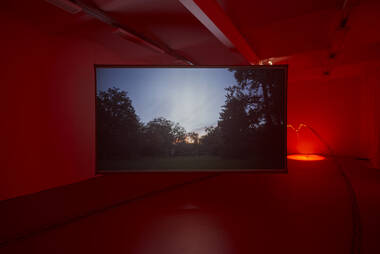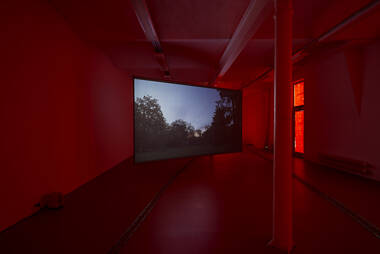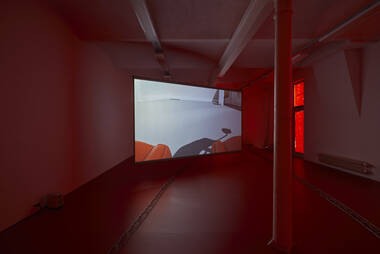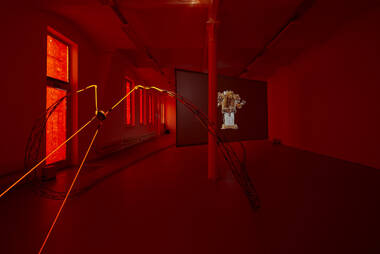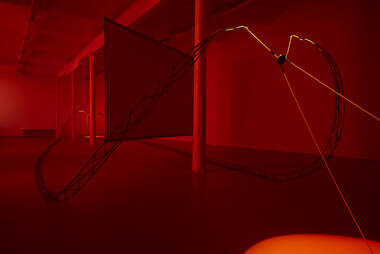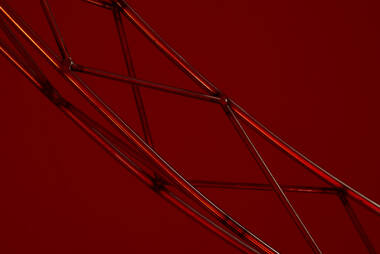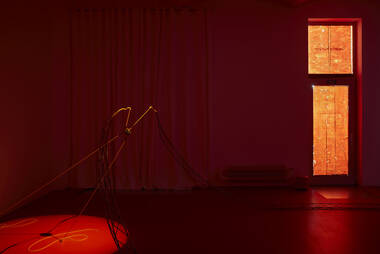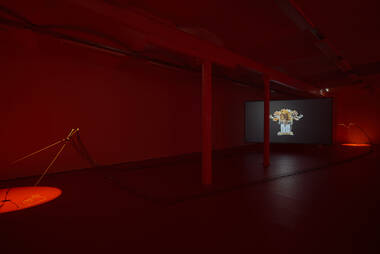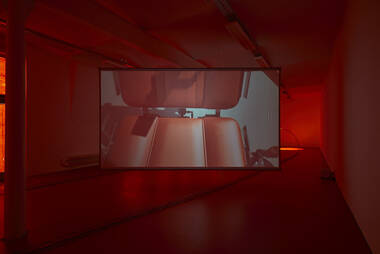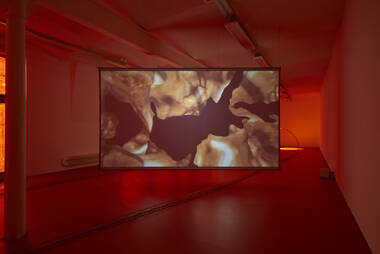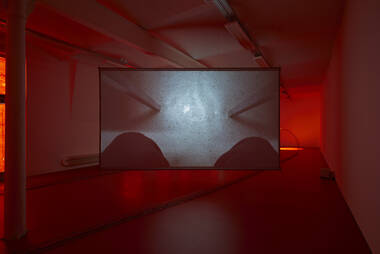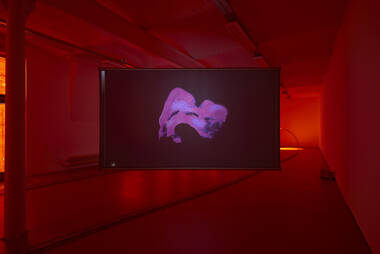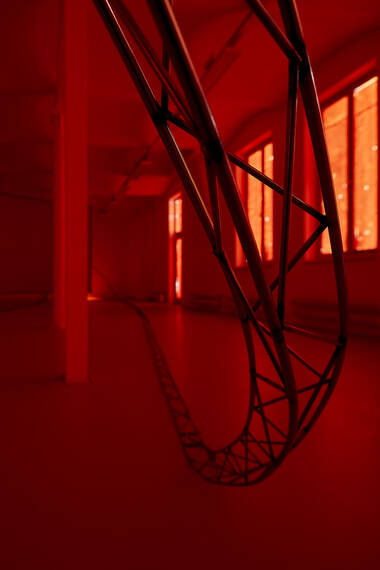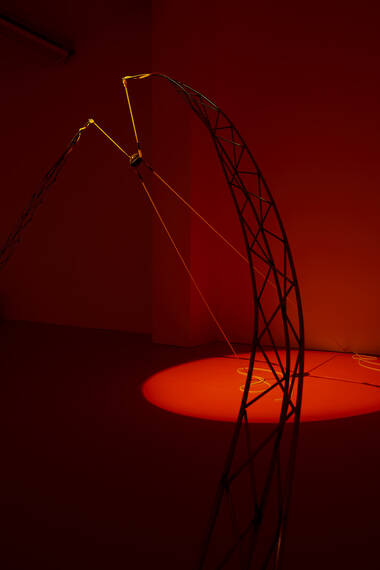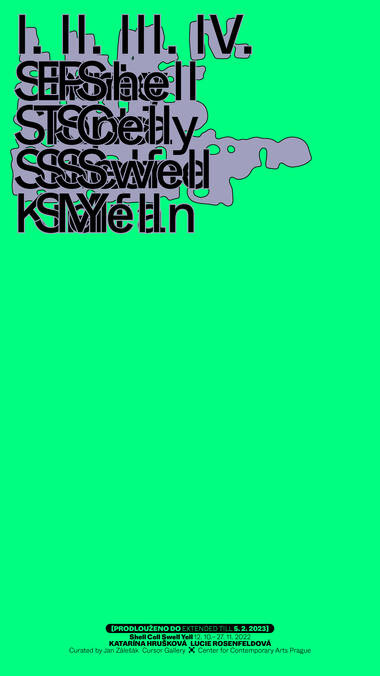Shell Cell Swell Yell
Katarína Hrušková and Lucie Rosenfeldová
12. 10. 2022 – 5. 2. 2023
opening: 11. 10. 2022 from 6 pm
curator: Jan Zálešák
Preamble
Here we are, in the gallery. Crouched on the floor, painted coral red, where a lightly rippling metal ellipse held together by hundreds of welds and lifting two tiny bronze shells at the furthest open ends at eye level, we determine the position of the projection screen using a long aluminium rod. We conducted initial tests with the projector yesterday, but now we see that we have to aim it a little differently. We envisage the visitors’ journey through space, we look at how various points of view stack up, and finally we agree that it’s okay for the screen to leave the space defined by the trajectory of the ellipse by means of its levitating surface. Moments later, Michal turns on Katarína’s track at full volume. The space gradually fills up until it overflows with booming, yelling, and the inhuman sounds of fairground rides. I look over to where Katarína is standing next to Michal watching the course of the soundtrack on the monitor. She is completely immersed in the progress of the track. Just as the sound of the fair begins to pulse through the deepest bass lines, she can’t help but react physically to the emotions the sound is arousing in her. She says nothing. She doesn’t have to. It’s quite enough that everything around her is screaming.
The roar which lies on the other side of silence
The bronze shells are not carried directly by the open ends of the ellipse. The metal construction, which on the floor still speaks the precise language of an engineering problematised only by the slight undulations of its trajectory, narrows as it moves upwards and its character is thus transformed. The joints between the continuous fibres shorten until only two slender steel wire-rods remain. Latex tubes are attached to the ends of these, which hold the shell bed from the other side. The opposing open ends of the ellipse thus form two taut slingshots with pockets of bronze shells, in which lie dark, silent, marble-egg projectiles pulsating with grey veins.
Upon entering the gallery this dual slingshot – the sculptural part of Katarína Hrušková’s installation entitled 2020, 2022 (slingshot ellipse) — can be taken in with almost a single glance. And although both ends, separated by the surface of the screen, are not visible to each other, they remain incontrovertibly connected into a single whole, defined by the artist’s experiences from the years inscribed in the title of the work. In the autumn of 2020, which will forever be associated in the historical imaginary with the onset of the Covid pandemic, Katarína learned she was pregnant. A few weeks later, another ultrasound revealed that the embryo’s development had terminated. The technologies in the gynaecologist’s office revealed a fact that her own body had not yet had time to process. The pain of the loss, intensified by the dissonance between the actual experience of the start of her pregnancy with all of its associated physical manifestations, and the awareness of its end, was exacerbated in the weeks to come by the fact that, in a world gripped by lockdowns and fear, it was very difficult to find comfort or at least distraction. In the spring of 2022, when the war in Ukraine broke out, Katarína suffered the same experience a second time. In both cases a personal point of pain and mourning found itself constellated with the collective pain and mourning of the world out there.
The soundtrack referred to in the preamble is part of 2020, 2022 (slingshot ellipse). It is a collage of field recordings of the soundscape of a funfair that took up residence in Katarína’s neighbourhood this spring. The din, the noise of machinery, the screeching, crashing and banging of metal on metal, is here combined with sounds emitted from human throats, stomachs and intestines; with screams in which the affective reactions growing out of bodily experience often cannot be clearly pigeonholed (fear, enthusiasm, excitement…). “The roar which lies on the other side of silence” resounds through the gallery space. Allowing ourselves to be permeated by its vibrations lets us experience subjectivity as both full and foreign, anchored in the “dark” matter of the body, predating the phenomena of speech and language that from a humanist perspective from the basic building blocks of the human self.
Humming melodies of détourned images
In the vibrating tension of matter (yellow silicon tubes and dark bass lines) the installation opens itself up to the experience of corporeality, i.e. the fundamental, material level of being, on which the relationships between diverse actors are formed on the horizontal plane, outside the hierarchy of spirit and matter on which Enlightenment rationality and with it modern science, stands. At this point we can listen to the first lines of the libretto to the short film by Lucie Rosenfeldová, accompanied by floating images from the “4D ultrasound” offered as a premium service during pregnancy by an increasing number of gynaecological clinics. Step by step we fold ourselves into a shifting matrix of different representations... The first feeling body shapes its image through the topography of touches from outside...
Looking back over the development of Lucie’s short films, the “fashioning of one’s own image”, the creation of one’s own subjectivity by means of a performative topography (of touching, walking, sitting...), stands out as an ongoing leitmotif. The key mechanism in the translation of the performative topography into the language of film is the camerawork. We see Lucie’s face in just about all of her films. The camera, handheld and capturing its surroundings from often “uncomfortable” angles, indifferent to the surface appeal of the shot, is a tool for anchoring itself in the terrain. The “alienated” (or rather radically appropriated) image of the camera, an image devoid of any rhetorical claim to objectivity asserted by the removal of traces hinting at the physical presence of the body behind the lens, is a fundamental component of the visual narrative. To the raw visual material captured by the camera, Lucie then adds technical images, whether these be screenshots or specially created animated sequences for her films.
While the camera shots serve to anchor the authorial subject (or the artist herself?) in the narrative whole of the film, the animated passages created using computer generated imagery tools are a space for critique and deconstruction, as well as for dreaming and fantasy: She lay back and focused on the unconditioned movements of her body… she did not feel herself to be part of anything, just as nothing was part of her… While the narrator’s voice utters these words, we watch the cursor pulling the y axis once above and once below the horizon formed by the line glowing on the surface of the screen (K managementu pochybnosti / On the Management of Doubt, 2014). Womb: In it the brain, in which is the womb. In it the brain, in which is the womb… (Hm..Fantasy..Hm, 2022). While the narrator’s voice utters the italicised words, we watch levitating images evoking soft tissues in the body’s cavities, the effect of which is deliberately complicated by the visible presence of the 3D software user interface.
Technical images, which represent another key component of Lucie’s films, feature in the visual narrative as derivatives of scientific images (maps, graphs, visualisations, scans...). Unlike the deliberately impoverished images captured by the camera, these are multilayered and replete with meaning. Amongst other things, they contain encoded claims and expectations relating to knowledge, management and control. Like the fragments of texts from scientific treatises, managerial manuals or the myths from which Lucie collages the narrative line of the libretto, the technical images, extracted from the contexts in which they are subject to strict expediency, are also subject to poetic détournement.
This is how Lucie Rosenfeldová’s new film operates. What to begin with appears to be an intimate, personal narration of random recollections from the gynaecologist’s office is gradually revealed to be a polemic, a head-on confrontation with the framework of scientific and medical practice. The film superimposes several differently situated narrative layers that do not necessarily correspond to the particular type of image. One takes place in the womb and the theme is the sexual dimorphism of the brain. Another takes place in medical facilities. Its narrator is the artist herself, and both personal and mediated memories are most often accompanied by the direct language of the camera. The third narrative involves a critique of pictorial representations and of the systems and institutions (of science and medicine) that create these representations and use them in ways that essentially meet the criteria of Foucault’s concept of biopolitics. Lucie unifies all of these narratives by means of poetically skewed images taken using the latest screening methods, in which medical pragmatics intermix with marketing strategies reflecting the commercialisation of healthcare.
Blind bats do not flit about the space of the gallery. Instead, we see cavities and holes floating in space, the animated offspring of 4D images. Can you guess where the black egg projectiles are heading?
Katarína Hrušková works with a wide range of media. Her starting point is photography, but gradually she has developed a complex modus operandi, often site-specific, in which sculptural, material-anchored approaches have the main say, expanded by sound, most often the spoken word, which brings a conceptual, narratival or atmospheric component to her installations. Katarína comes from Slovakia. She studied in Amsterdam and London and lives and works in Berlin and Ružomberok.
Lucie Rosenfeldová works mainly with the medium of video (short film). Characteristic of her work is a tension between a poetic and analytical narrative, in which the personal encounters a feminist critique of the systems of science, law and medicine. After quickly mastering the expressive possibilities of the video essay, she became interested in expanding the bandwidth of this genre. Lucie studied in Ostrava and Prague, where she now lives and works.
The program of the Cursor Gallery is possible through kind support of Ministry of Culture of the Czech Republic, Prague City Council, State Fund of Culture of the Czech Republic, City District Prague 7, GESTOR – The Union for the Protection of Authorship
Partners: Kostka stav
Media partners: ArtMap, jlbjlt.net, Náš REGION
and Mladý svět and UMA: You Make Art
